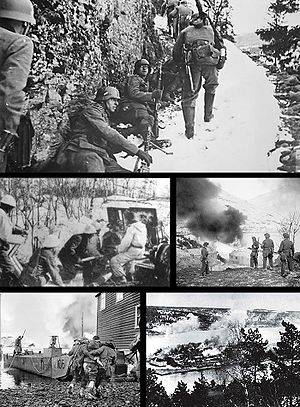
Back الحملة العسكرية على النرويج Arabic Norveç kampaniyası Azerbaijani نوروژ ساواشی AZB Emgann Norvegia Breton Angrebet på Norge under 2. verdenskrig Danish Kampanjo de Norvegio Esperanto Campaña de Noruega Spanish Norra vallutamine 1940 Estonian نبرد نروژ Persian Taistelu Norjasta Finnish
| Norwegian campaign | |||||||||
|---|---|---|---|---|---|---|---|---|---|
| Part of the Operation Weserübung | |||||||||
 The Battle of Narvik saw Norway's toughest fight in World War II; nearly 7,500 Norwegian soldiers participated in the battle, along with British, French and Polish troops. The reconquest of Narvik was the first time the Third Reich war machine had to be removed from a captured city. | |||||||||
| |||||||||
| Belligerents | |||||||||
|
|
| ||||||||
| Commanders and leaders | |||||||||
|
|
(9–10 April) (From 10 April) (From 15 April) | ||||||||
| Strength | |||||||||
|
100,000 7 divisions 1 Fallschirmjäger battalion |
Norway: 52,000 6 divisions Allies: 38,000 Total: 90,000 | ||||||||
| Casualties and losses | |||||||||
|
Official German figures: 5,296 (1,317 killed on land 2,375 lost at sea 1,604 wounded) Material losses: 1 heavy cruiser 2 light cruisers 10 destroyers 6 U-boats 2 torpedo boats 15 light naval units 21 transports/merchant ships 90–240 aircraft |
Total: 6,602 British: On land: 1,869 killed, wounded, injured & missing At sea: 2,500 lost 1 aircraft carrier 1 heavy cruiser 1 light cruiser 7 destroyers 1 submarine 112 aircraft French and Polish: 533 killed, wounded & missing 2 destroyers 2 submarines Norwegian: 1,700 total, of whom 860 were killed 107 naval ships sunk or captured 70 merchant ships & transports sunk (combined Norwegian/Allied total) | ||||||||
|
Civilian (Norwegian) casualties: 535 killed | |||||||||
The Norwegian campaign (8 April – 10 June 1940) involved the attempt by Allied forces to defend northern Norway coupled with the resistance of the Norwegian military to the country's invasion by Nazi Germany in World War II.
Planned as Operation Wilfred and Plan R 4, while the German attack was feared but had not yet happened, the battlecruiser HMS Renown set out from Scapa Flow for Vestfjorden with twelve destroyers on 4 April. The Royal Navy and the Kriegsmarine met at the first and second naval battles of Narvik on 10 and 13 April, and British forces conducted the Åndalsnes landings on 13 April. The main strategic reason for Germany to invade Norway was to seize the port of Narvik and guarantee the delivery of iron ore needed for German steel production.[1]
The campaign was fought until 10 June 1940 and saw the escape of King Haakon VII and Crown Prince Olav to the United Kingdom. A British, French and Polish expeditionary force of 38,000 troops landed in the north. It had moderate success but made a rapid strategic retreat after the Battle of France began on 14 May. The Norwegian government then went into exile in London. The campaign ended with the occupation of the entirety of Norway by Germany but elements of the Norwegian military escaped and fought on overseas.